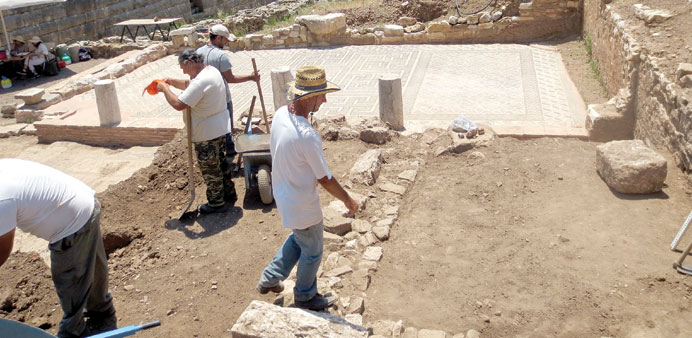AT WORK: Archaeologists excavate the ruins of a private dwelling in Ancient Messene in Greece.
By Christine Pirovolakis
Every year, vast numbers of tourists flock to the Acropolis in Athens to photograph a key remnant of ancient Greece. Very few visit a valley flanked by olive groves and fertile mountains with equally impressive monuments in rural Greece.
Messene, in the south-western Peloponnese, is among the most impressive archaeological sites in the country, but is little known.
For the past 29 years, ongoing excavations in Messene by Petros Themelis and his associates have uncovered an elaborate ancient city, complete with theatres, a stadium, breath-taking temples, sanctuaries, water fountains, statues and private residences.
Defensive walls surround it.
“All the findings point to the fact that Messene was an outlying region in the ancient Greek world that began to grow as the other big centres began to decline,” said Professor Themelis.
“It enjoys, among other things, the advantage of never having been destroyed or covered by later settlements, since the villages were located outside the ancient walls.”
Ancient Messene was built in 369 BC by the Theban general Epameinondas after he had defeated the Spartans.
They were longtime enemies. The Spartans had enslaved the Messenians in the 8th century BC for more than two centuries.
The Messenians were known as Helots to the Spartans, who used them to farm their land while male Spartans were off fighting.
The new city was built by the Greek architect and urban planner Hippodamus, using pioneering town-planning and fortification techniques. It was considered larger than ancient Athens, covering 290 hectares of land.
Ancient Messene flourished during the Hellenistic and Roman period, thanks to its rich agricultural and livestock production and trade with Italy, Crete and Egypt.
Its fortifications, which were 9.5 kilometres in length, helped to make it the most heavily defended city in Greece. Its public buildings and temples were accessible to all.
Most impressive among them was a complex comprising the gymnasium and stadium of Heroon, which had a length of 200 metres, as well as the theatre, which could seat 12,000 spectators and was not only used for performances, but also as a place for political meetings.
Excavations over the years have brought more than 18,000 artefacts to light, including the Asklepeion, a group of buildings originally adorned with more than 100 bronze and stone statues and dedicated to Asclepius, the god of medicine and healing.
Other sites to emerge are the temple of Poseidon, the sanctuary of Demeter and the Dioskouroi and the ancient market-place or agora.
Archaeologists have unearthed large chambers to the east of the Asklepeion which contained the ekklesiasterion, a small theatre-like assembly hall for political gatherings, plays and musical performances as well as the bouleuterion, a council hall used for meetings of representatives of Messenian cities, and an archive.
Opposite the ekklesiasterion stood a series of niches that represented small shrines or sanctuaries, including one dedicated to Artemis, the goddess of the hunt.
“Every aspect of the architecture was designed to express beliefs about democracy, equality before the law and equal property rights,” said Themelis as he proceeded to sweep away dirt from a circular Roman-era structure with exquisite mosaic floors.
“The city was built in a way that ensured the equal distribution of land between the rich and poor, while everyone could access its majestic centre, comprising the agora as well as all of its public buildings and religious monuments.”
For more than six decades, the ancient theatre of Messene hosted cultural and political events attended by major historical figures of the time, such as King Philip V of Macedonia.
Last summer, after 1,700 years in silence and decay, the restored theatre reopened its gates to the public with an opera performance.
“When we started with the excavations we were disappointed because the theatre was actually non-existent. There were only a few benches and surrounding olive groves,” said Themelis.
The theatre’s restoration was funded by the 2nd and 3rd Community Support Framework and the Stavros Niarchos Foundation.
He said a funding crisis by the Greek government has left archaeologists heavily reliant on private funds to continue excavations at the site.
“The Ministry of Culture simply does not have the money for excavations and to cover the expenses of the archaeologists, but only for restoration work,” said Themelis.
A new initiative is in the works which will allow guests from the nearby Costa Navarino resort to work side-by-side with the team of archaeologists on the excavation and reconstruction of ancient Messene site for a period of one day or a week. — DPA

